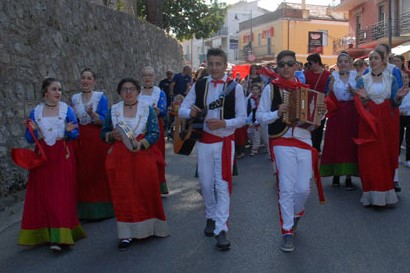
Arbëreshe costume festival
Who are the Arbëreshe?
The term 'Arbëreshe' is used to define a population of Albanian language and culture living in Southern Italy, who arrived here between the fifteenth and seventeenth centuries.
Over the course of time, despite their contacts with Italian culture, this population has succeeded in maintaining its Albanian identity, thanks also to the cultural role exercised by the two religious Institutions of Eastern rite, that of Grottaferrata, in Lazio, and that of Piana degli Albanesi, in Sicily.
The Arbëreshe tradition, interpreted as the transfer and inevitable fusion of Albanian and Italian cultural characteristics, is a combination of customs, dialects, costumes and myths (above all that of Skanderbeg, Giorgio Castriota in Italian) that in the Arbëreshe villages are jealously guarded even today.
In Calabria the Albanian language (Arbëreshe) is spoken in 34 centers, among municipalities and hamlets: 25 are located in the province of Cosenza, 3 in the province of Crotone and 6 in the province of Catanzaro.
In Calabria, according to consolidated historical studies, the first transfer of Albanians dates back to the fifteenth century, when Alfonso I of Aragon used the services of Demetrio Reres, a noble Albanian leader, who brought with him a large contingent of men.
The reward for his services consisted of the donation, in 1448, of some territories in the region. According to sources, Demetrio Reres came to Calabria to restore the obedience of the barons who had rebelled against the King’s authority, at the head of which was the Marquis Antonio Centelles.
Demetrius Reres then arrived at the command of a group of armed men who, as was the custom at the time, brought their families with them.
As a compensation for the services rendered, the King of Naples appointed him Governor of Calabria.
Centelles was defeated in February 1445: it is to this period, in fact, that date back the first Albanian settlements, which were established on territories confiscated from the Marquis Centelles himself.
The Albanians were distributed in different villages of the province of Catanzaro going to repopulate farmhouses which were abandoned at the time, thus, initiating the work of restoration and revitalization of the territory: the first settlements were Amato, Andali, Arietta, Vena and Zangarona, followed by Caraffa, Carfizzi, Pallagorio San Nicola dell'alto and Gizzeria.
The migration of Albanians towards Calabria and Southern Italy was favored by two important events in the history of the country: the marriage between Irene Castriota and the Prince of Bisignano in Calabria, in 1470, and the fall of the city of Kruja in 1478.
The marriage between Luca Sanseverino and Irene, great-granddaughter of the hero Skanderbeg, is still recalled today in the streets of the country with a large parade in period costumes, as part of the events surrounding the Palio of Bisignano that take place on the penultimate Sunday of June: at that time this illustrious wedding represented an excellent move in the so-called 'marriage strategy' of the Calabrian nobles.
On the other hand, as far as the fall of Kruja (Croia in Italian, Kruje in Arbëreshe) to the Turks is concerned, this had a psychological rather than political significance: in fact, Skanderbeg was born there and fought for his hometown to the last, thus instilling in the Albanians of Cruja a confidence and tenacity that made them resist for the five long months of siege.
Cruia's resilience became proverbial throughout Europe for decades and the Albanians made it a symbol of their cultural and territorial identity.
Its fall into Turkish hands therefore also meant for most people the need to find new places for their independence. The last great wave of migration occurred after the conquest by the Turks of another important Albanian fortress, that of Corone, in 1533-34.
The Albanians who migrated kept the Christian religion of orthodox rite and this is still one of the characteristic features of ethnic Albanians both compared to the rest of the population and to the Albanians who remained at home.
(Text written by Dr. Michele Minisci)


